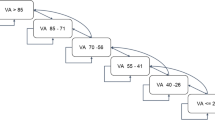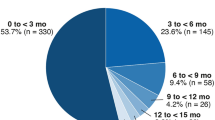Abstract
Faricimab (faricimab-svoa; Vabysmo™) is a bispecific antibody that binds to and inhibits both vascular endothelial growth factor (VEGF)-A and angiopoietin-2 (Ang-2). Administered by intravitreal injection, faricimab is being developed by Roche/Genentech for use in the treatment of retinal vascular diseases. In January 2022 faricimab received its first approvals, in the USA, for use in the treatment of patients with neovascular (wet) age-related macular degeneration (nAMD) or diabetic macular edema (DME). Faricimab has also recently been approved in Japan, and is currently under regulatory review in the EU, for use in nAMD and DME. Phase III clinical development of faricimab for use in the treatment of nAMD, DME, and macular edema due to retinal vein occlusion is continuing in multiple other countries worldwide. This article summarizes the milestones in the development of faricimab leading to these first approvals for nAMD and DME in the USA.
Similar content being viewed by others
References
Adamis AP, Brittain CJ, Dandekar A, et al. Building on the success of anti-vascular endothelial growth factor therapy: a vision for the next decade. Eye (Lond). 2020;34(11):1966–72.
Baumal CR. Wet age-related macular degeneration: treatment advances to reduce the injection burden. Am J Manag Care. 2020;26(5 Suppl):S103–11.
Glassman AR, Wells JA 3rd, Josic K, et al. Five-year outcomes after initial aflibercept, bevacizumab, or ranibizumab treatment for diabetic macular edema (Protocol T extension study). Ophthalmology. 2020;127(9):1201–10.
Ciulla TA, Pollack JS, Williams DF. Visual acuity outcomes and anti-VEGF therapy intensity in diabetic macular oedema: a real-world analysis of 28 658 patient eyes. Br J Ophthalmol. 2021;105(2):216–21.
Heier JS, Singh RP, Wykoff CC, et al. The angiopoietin/Tie pathway in retinal vascular diseases: a review. Retina. 2021;41(1):1–19.
Khanani AM, Russell MW, Aziz AA, et al. Angiopoietins as potential targets in management of retinal disease. Clin Ophthalmol. 2021;15:3747–55.
US FDA. VABYSMO™ (faricimab-svoa) injection, for intravitreal use - US prescribing information. 2022. https://www.fda.gov. Accessed 4 Mar 2022.
Roche. FDA accepts application for Roche's faricimab for the treatment of neovascular age-related macular degeneration (nAMD) and diabetic macular edema (DME) [media release]. 29 Jul 2021. https://www.roche.com. Accessed 4 Mar 2022.
US FDA. BLA approval - Vabysmo. 21 Jan 2022. https://www.accessdata.fda.gov/drugsatfda_docs/appletter/2022/761235Orig1s000ltr.pdf. Accessed 4 Mar 2022.
Chugai Pharmaceutical Co. Chugai obtains regulatory approval for Vabysmo, the first bispecific antibody in ophthalmology, for neovascular age-related macular degeneration and diabetic macular edema [media release]. 28 Mar 2022. https://www.chugai-pharm.co.jp/english/news/detail/20220328160002_909.html. Accessed 19 Apr 2022.
European Medicines Agency. Committee for medicinal products for human use (CHMP): draft agenda for the meeting on 21-24 June 2021 [media release]. 21 Jun 2021. https://www.ema.europa.eu/en/documents/agenda/agenda-chmp-agenda-21-24-june-2021-meeting_en.pdf. Accessed 4 Mar 2022.
Canonica J, Uhles S, Foxton R, et al. VEGF-A/Ang-2 neutralization causes sustained prevention of subretinal macrophage infiltration in a mouse model of spontaneous choroidal neovascularization [abstract]. Invest Ophthalmol Vis Sci. 2021;62(8):274.
Linder M, Foxton R, Uhles S, et al. Simultaneous Ang-2/VEGF-A inhibition prevents subretinal fibrosis progression in preclinical mouse models of choroidal neovascularization (CNV) [abstract]. Invest Ophthalmol Vis Sci. 2021;62(8):349.
Wykoff CC, Abreu F, Adamis AP, et al. Efficacy, durability, and safety of intravitreal faricimab with extended dosing up to every 16 weeks in patients with diabetic macular oedema (YOSEMITE and RHINE): two randomised, double-masked, phase 3 trials. Lancet. 2022;399(10326):741–55.
Heier JS, Khanani AM, Quezada Ruiz C, et al. Efficacy, durability, and safety of intravitreal faricimab up to every 16 weeks for neovascular age-related macular degeneration (TENAYA and LUCERNE): two randomised, double-masked, phase 3, non-inferiority trials. Lancet. 2022;399:729–40.
Chakravarthy U, Bailey C, Brown D, et al. Phase I trial of anti-vascular endothelial growth factor/anti-angiopoietin 2 bispecific antibody RG7716 for neovascular age-related macular degeneration. Ophthalmol Retina. 2017;1(6):474–85.
Khanani AM, Patel SS, Ferrone PJ, et al. Efficacy of every four monthly and quarterly dosing of faricimab vs ranibizumab in neovascular age-related macular degeneration: the STAIRWAY phase 2 randomized clinical trial. JAMA Ophthalmol. 2020;138(9):964–72.
Sahni J, Dugel PU, Patel SS, et al. Safety and efficacy of different doses and regimens of faricimab vs ranibizumab in neovascular age-related macular degeneration: the AVENUE phase 2 randomized clinical trial. JAMA Ophthalmol. 2020;138(9):955–63.
Sahni J, Patel SS, Dugel PU, et al. Simultaneous inhibition of angiopoietin-2 and vascular endothelial growth factor-A with faricimab in diabetic macular edema: BOULEVARD phase 2 randomized trial. Ophthalmology. 2019;126(8):1155–70.
Author information
Authors and Affiliations
Corresponding author
Ethics declarations
Funding
The preparation of this review was not supported by any external funding.
Authorship and Conflict of interest
During the peer review process the manufacturer of the agent under review was offered an opportunity to comment on the article. Changes resulting from any comments received were made by the authors on the basis of scientific completeness and accuracy. M. Shirley is a salaried employee of Adis International Ltd/Springer Nature, and declares no relevant conflicts of interest. All authors contributed to the review and are responsible for the article content.
Ethics approval, Consent to participate, Consent to publish, Availability of data and material, Code availability
Not applicable.
Additional information
This profile has been extracted and modified from the AdisInsight database. AdisInsight tracks drug development worldwide through the entire development process, from discovery, through pre-clinical and clinical studies to market launch and beyond.
Supplementary Information
Below is the link to the electronic supplementary material.
Rights and permissions
About this article
Cite this article
Shirley, M. Faricimab: First Approval. Drugs 82, 825–830 (2022). https://doi.org/10.1007/s40265-022-01713-3
Published:
Issue Date:
DOI: https://doi.org/10.1007/s40265-022-01713-3




